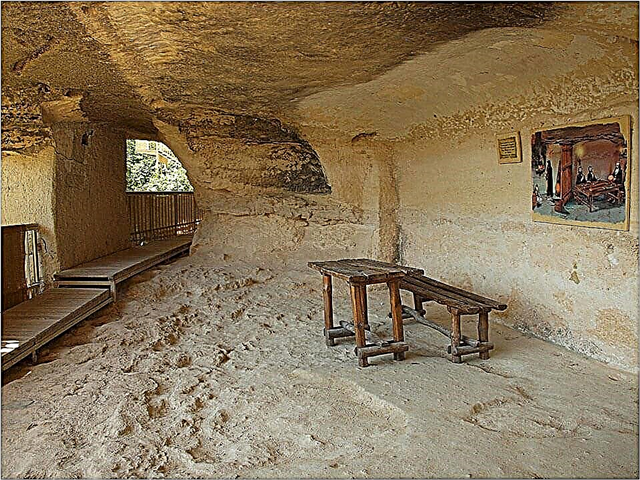Some tourists who have visited Rome, Naples and Milan arrogantly claim that they already know almost everything about Italy.
Content:
Short description
Naturally, this opinion is erroneous: it is enough to be in the small town of Assisi, and the realization that mysteries and many interesting monuments of history and architecture are “hiding” in small towns. Despite its size and small population, Assisi will be of interest to all travelers without exception who arrived on the Apennine Peninsula to get acquainted with one of the most interesting countries of the Old World, which in ancient times ruled "the whole world."

General view of Assisi
"A mystical and mysterious city, which is marked with a special seal of the higher powers" - this is what Italians say about the oldest Latin (!) City, spread out in a commune called Umbria, just two hours by car from the capital of the country. Any indigenous Italian knows about Assisi and speaks of this city with particular trepidation. The fact is that it was in him that St. Francis was born, who among Catholics is considered the patron saint of the whole country and gives it eternal prosperity.
It is he who is the founder of the most revered order in Catholicism. The history of the life of this saint already in itself arouses extraordinary interest, it should even be dwelled on in a little more detail in this material, because All Catholics, without exception, associate Assisi with Saint Francis in the first place., and only then with a huge number of attractions that delight all, without exception, guests of the city.

Assisi makes a special impression on its guests in late autumn: at that time of the year when fashion shows are not so often held in Milan, and it gets chilly on numerous beaches. With the onset of the first cold weather (the word "cold" in Italy is applicable even to a temperature of +5 degrees Celsius) the cozy city is filled with tourists. In late October and early November, some travelers even face an acute shortage of available hotel rooms. There is absolutely nothing to be surprised at: in Assisi, new buildings are being erected only with the special permission of the commission, so as not to violate the harmony that has developed over several centuries.
Numerous churches, the most powerful fortress walls, a huge number of houses built in the dark Middle Ages are something like an open-air museum. Many guides who conduct excursions around Assisi quite often insist that this city is a museum, and all its architectural masterpieces and historical monuments can be safely called exhibits of a huge exhibition. By the way, you need to hurry to see the Italian city of Assisi with your own eyes, because very soon, according to geologists, it will disappear underground forever. Assisi does not have its own airport, the closest is located in the city of Perugia, from which you can get to Assisi by regular bus.

Basilica of Saint Francis
Basilica of Saint Francis
St. Francis, to whom almost all Italians turn in their prayers, was born in the city of Assisi. True, then he had a slightly different name "Assisium", because, as mentioned above, we are talking about a Latin city. Francis founded the same legendary Catholic Franciscan mendicant order, and without exception, all the sights of modern Assisi are inextricably linked with the name and fate of this person, classified as a saint... Giovanni Francesco di Pietro Bernardone (this is how the full name of the Saint sounds) was not always a beggar, on the contrary, his parents were considered one of the richest people in Assisi. From his youth, he showed an interest in the Catholic faith and often gave churches money earned ... by his father. Naturally, the head of the family was not satisfied with such a generosity of his son, and he imprisoned him for some time in a cell.

Basilica of Santa Chiara
After his release, the young man suddenly began to lead a riotous life: they knew about his tricks in every tavern in a Latin city. The future saint even managed to visit the war with Perugia, but was captured in the first battle. After Giovanni Francesco di Pietro Bernardone once again breathed deeply the "air of freedom", he immediately returned to his usual way of life. If not for the military campaign in southern Italy, his name would have remained unknown. During a military operation, a native of Assisi heard the voice of God: he immediately renounced all earthly goods and even his family. Saint Francis founded an order in which the beggarly way of life was of great importance. “A monk should not use any wealth. He must leave this world and spend all his free time in prayer, ”- so Francis said to his associates. By the way, since the founding of the Franciscan order, visible changes have taken place in Catholicism: many monks have ceased to compete with each other in the amount of gold accumulated over their lives. Moreover, those people who dedicated themselves to serving God no longer led a secluded life, on the contrary, they, "leaving the world, went back to it in order to convey the word of God to sinners."

Cathedral of San Rufino
Attractions Assisi
The whole of Assisi itself is a monument of history and culture, but if you try to highlight one of the main attractions of the city, then it will, of course, be the Basilica of St. Francis... This temple cannot be called big, its enormous importance for every Catholic: it is to this two-story building that thousands of pilgrims come to offer their prayers to the patron saint of Italy. The basilica, built on Paradise Hill, has a rather rich interior. Her style is classic, or, as it is often called, Romanesque. Speaking of Paradise Hill, it is named so only in numerous tourist avenues around the city, earlier its name was different ... Hell's Hill.
“Why did the hill on which St. Francis was buried bear such a terrifying name?” - such a question may be asked by a tourist who has not yet had time to get to know Assisi. The thing is that until the 13th century, criminals were constantly publicly hanged on this picturesque hill. After learning about this story, the place where the Basilica of St. Francis is located no longer seems so attractive. By the way, the local population still calls this hill "Hellish", and does not accept any other names. Some even argue that during dusk at the basilica you can see ... ghosts. There has always been a special attitude towards the dead in Assisi: in many old houses there are two entrances at once.

Rocca Maggiore Fortress
More precisely, one door serves as both an entrance and an exit, and the second only an exit. They enter the house only through a wide entrance without steps, and come out through it, but only the living ... Through a narrow exit with steps they carried out the dead. True, this custom has already sunk into oblivion, but for some reason no one is in a hurry to brick up the "doors for the dead". Most likely, they were left so that the tourist does not get the impression that any changes have taken place in the Italian city since the Middle Ages.
After visiting the Basilica of St. Francis, you should definitely go to the local Pinakothek, which has a huge collection of paintings for such a city. A ticket to this museum will cost the traveler a purely symbolic amount - 3 euros. In addition, the medieval fortress called Rocca Maggiore will also be of great interest. It was built to defend the city during the long war with Perugia. This fortification, which offers a magnificent view of Assisi, was the birthplace of the cruel ruler of the Roman Empire, Frederick II.... It is interesting that according to legend, the birth of the emperor and the future saint was predicted by a seer. Once a monk appeared in Assisi, who gathered around him most of the city's population and said: "Two people have come to our world today, one of whom will become the best in the future, and the second, the most cruel and bad." Naturally, the best person was a baby named Giovanni Francesco di Pietro Bernardone, who would later become a saint and organize a mendicant order.

New church
As has been mentioned several times in this article, the whole city consists of attractions, any street will lead to any monument. However, to see another interesting sight that has appeared quite recently, you should leave the city. This road is about three kilometers long and is made of bricks. On each brick you can read the name of the person who donated to the city budget ... 40 euros.
Modern Assisi: medieval charm
“A trip and a walk through one of the most beautiful Italian cities, stretched among green hills, is akin to traveling in time” - this banal and rather hackneyed phrase, nevertheless, is the best fit for a brief description of Assisi. As mentioned at the very beginning of the material, the city managed to avoid destruction during numerous wars and appears before the tourist in the form in which the indigenous people saw it in the Middle Ages. Narrow streets, along which you constantly have to go down and down, constantly make tourists think that time has stopped in this small Italian town, located right on the southern slope of the most beautiful mountain called Monte Subasio.

Palace of the People's Captain (with a bell tower) and the Temple of Minerva (facade with columns) in the Commune Square
Entering Assisi for any traveler may feel like a huge car park. For those who do not yet know about the homeland of the famous Italian poet Sextus Propertius and Saint Francis, it will be interesting to know that it is almost unrealistic to travel by car along the narrow streets of a small medieval town, which is visited by tens of thousands of Catholic pilgrims every year. The authorities of the country did their best so that in Assisi any tourist could easily get a complete picture of how people lived at a time when the church had almost unlimited power in most of the Old World. This city and its population knew firsthand what the Holy Inquisition and the witch hunt were.
In Assisi, you can touch the most powerful fortress wall, erected at the beginning of the 13th century, and visit many Catholic churches and basilicas. After visiting this Italian city, many tourists claim that it is in it that the most churches are located. Naturally, this is only an impression, there are many more of them in Rome. The thing is that quite a few churches are located on a small territory, and narrow streets all the time lead to some kind of temple. Speaking of streets, in Assisi even a staircase leading to a building can be considered a street and have its own name. It is not difficult to find any attraction in the city, it is much more difficult to find a way out of it without the help of a guide.

Church of San Pietro
Assisi seems gloomy only at the first meeting: all of its locals have a subtle sense of humor and love noisy holidays and feasts... In the city, right next to its main attractions, various festivals are constantly held, in which musicians and singers from all over Italy take part. Souvenir shops also deserve special attention: they offer ceramic figurines and paintings depicting ... well-fed and satisfied monks. And all this despite the fact that almost every historical and architectural monument in the city is associated with the name of St. Francis. You can't leave Assisi without shopping: this truth is familiar to everyone who has visited this Italian city of contrasts. Local embroidery is most in demand here; by the way, it is also related to Francis. According to legend, the craftswomen from Assisi learned to embroider beautiful paintings according to the pattern that the Saint gave them. He, in turn, received this sample from the crusaders who returned from another campaign for the faith.

On the streets of the city
The attitude towards the poor in Assisi is surprising: despite the main idea of the order created by St. Francis, the city has a law according to which it is forbidden to ask for alms from all churches. A poor man who asked for a few euro cents from a tourist can go to jail for several days for his "offense".











